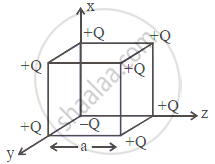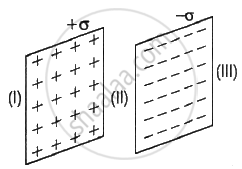Advertisements
Advertisements
Question
Solve numerical example.
Calculate the electric field due to a charge of −8.0×10−8 C at a distance of 5.0 cm from it.
Solution
Given: q = −8.0×10−8 C, r = 5 cm = 5 × 10−2 m
To find: Electric field (E)
Formula: E = `1/(4πε_0)"q"/"r"^2`
Calculation: From formula,
E = `9xx10^9xx((-8xx10^-8))/(5xx10^-2)^2`
= −2.88 × 105 N/C
Electric field due to a charge is −2.88 × 105 N/C.
APPEARS IN
RELATED QUESTIONS
Choose the correct option.
Which of the following produces uniform electric field?
Answer the following question.
What is a uniform electric field?
Answer the following question.
If two lines of force intersect of one point. What does it mean?
A charge +q exerts a force of magnitude -0.2 N on another change -2q. If they are separated by 25.0 cm, determine the value of q.
Solve numerical example.
Four charges of + 6×10-8 C each are placed at the corners of a square whose sides are 3 cm each. Calculate the resultant force on each charge and show in the direction and a diagram drawn to scale.
A conducting sphere of radius R = 20 cm is given a charge Q = 16 µC. What is `vecE` at centre?
An electron at rest is accelerated by a potential 'V1', in uniform field experiences a force 'F1'· When potential is changed to 'V2', the force experienced by the electron gets doubled. The ratio of V1 to V2 is ______.
An electron experiences a force equal to its weight, when placed in an electric field. The intensity of the field will be ______.
Radius of a metal sphere is 4 cm. It is given a charge of 8 µC. The force acting on unit area of its surface is ____________.
Deuteron and `alpha` - particle are put 1 Å apart in air. Magnitude of intensity of electric field due to deuteron at `alpha` - particle is ____________.
The magnitude of point charge due to which the electric field 30 cm away has the magnitude 2 NC-1 will be ____________.
A particle of mass m and charge q is placed at rest in a uniform electric field E and then released, the kinetic energy attained by the particle after moving a distance y will be ______.
The energy density of a medium is 3.54 x 10- 5 J/m3. The intensity of electric field in the medium of dielectric constant 2 is ______.
A large metal plate of area 1.0 m2 is placed in electric field. The magnitude E of the electric field is 5.5 N/C. What is the magnitude of charge on the plate?
A cube of side 'a' has point charges +Q located at each of its vertices except at the origin where the charge is -Q. The electric field at the centre of cube is ______.

A charged particle (mass m and charge q) moves along X axis with velocity V0. When it passes through the origin it enters a region having uniform electric field `vec"E" = -"E"hat"j"` which extends upto x = d. Equation of path of electron in the region x > d is :

A positive charge particle of 100 µg is thrown in opposite direction to a uniform electric field of strength 1 × 105 NC-1. If the charge on the particle is 40 µC and the initial velocity is 200 ms-1, how much distance it will travel before coming to the rest momentarily:
An oil drop of radius 2 mm with a density 3 g cm-3 is held stationary under a constant electric field 3.55 × 105 V m-1 in the Millikan's oil drop experiment. What is the number of excess electrons that the oil drop will process?
Consider g = 9.81 m/s2
The electric field in a region of space is given by, `vec"E"= "E"_"o"hat"i" + 2"E"_"o"hat"j"` where Eo = 100 N/C. The flux of the field through a circular surface of radius 0.02 m parallel to the Y-Z plane is nearly ______.
An electron of mass me and a proton of mass mp are kept in a uniform electric field. The ratio of the acceleration of electron (ae) to the acceleration of proton (ap) is ______.
Which of the following configuration of electric lines of force is not possible?
If the potential in a region of the electric field is expressed as V(x, y, z) = 2xy + 3zx - yz, then the electric field at point (0, 1, 1) is ______.
Find the electric field in region II as in figure shown.

